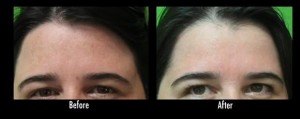Acne scar patients often wonder if they should undergo treatment options like:
– Chemical peels
– Dermabrasion
– Microdermabrasion
These procedures basically attempt to remove surface layers in order to improve the appearance of the skin.
As the name suggests, chemical peels involve the use of various types of chemicals to induce the peeling of the skin.
Dermabrasion is a surgical sanding technique intended to abrade the surface and upper layers of the skin in a controlled manner. The tool used can be a diamond fraise or metallic surface that is textured.
Microdermabrasion can be described as more of a non-surgical exfoliation process using microscopic particles.
Understanding how acne scar tissue forms will help you determine which treatment options make more sense than others.
How Acne Scar Tissue Develops
Acne scars result from inflammation of the skin due to acne. The presence of bacteria triggers the immune system, whose job is to attack foreign bodies. White blood cells are rallied causing enlargement of the acne pimples and overall skin redness. This is a traumatic event that the skin responds to by forming disorganized arrays of collagen fibers which make up the acne scar tissue.
Choosing Between Surface Treatment Options and Lasers for Acne Scar Tissue
Acne scars tissue is made thick collagen structures that are interwoven within the overall fabric of the skin. So peeling away the top surface using chemical peels will not produce significant improvements for acne scar treatment, especially with more severe cases. This is also true of microdermabrasion as well.
Because dermabrasion is a controlled surgical method, it can produce positive results for certain candidates. However the process is quite bloody and may incur complications. And the recovery time is substantial.
Instead of trying to address acne scar issues from the surface level down, laser treatment options like Fraxel Dual and Fraxel Repair instigate the formation of normal and new collagen fibers. Specific levels of laser energy are converted to heat energy. When this is applied to deeper layers, the skin tries to heal itself from the heat by creating normal forms of collagen fibers that are organized in their arrangement like the rest of your skin.
Over the course of several treatments the normal collagen gradually overrides the collagen of the acne scars.
Lasers offer a controlled means for addressing acne scars without the risk of significant complications. And downtime is relatively minimal.

